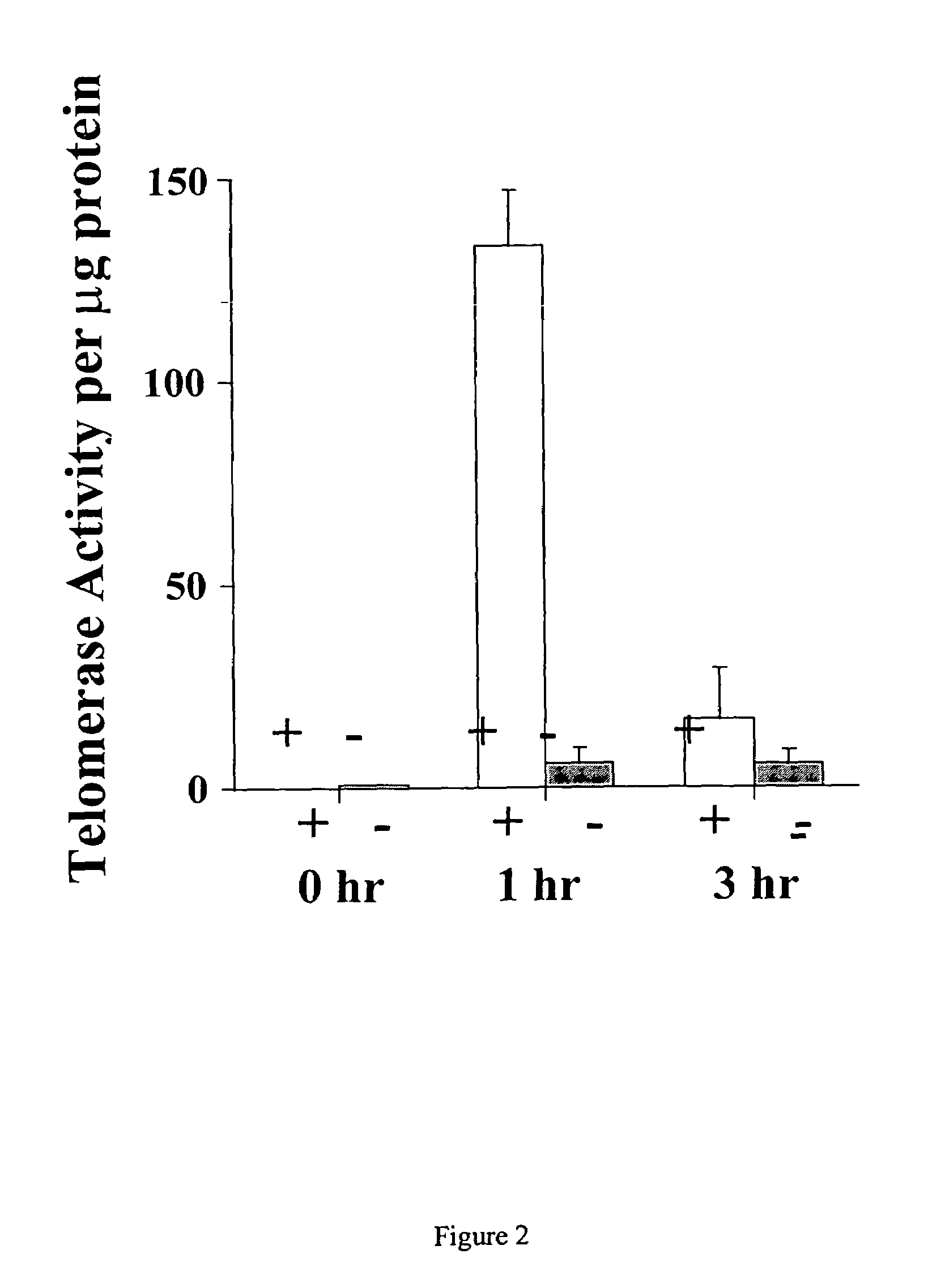Methods and compositions for modulating drug activity through telomere damage
a technology of telomere damage and drug activity, which is applied in the direction of carbohydrate active ingredients, animal husbandry, biocide, etc., can solve the problems of telomere loss, cell death, and inability to demonstrate significant antitumor activity of telomerase inhibitors, so as to avoid damage-induced resistance to paclitaxel and resistance to paclitaxel treatment
- Summary
- Abstract
- Description
- Claims
- Application Information
AI Technical Summary
Benefits of technology
Problems solved by technology
Method used
Image
Examples
example 1
Methods for Improved Measuring of Telomerase Activity
[0216]In the previously described polymerase chain reaction (PCR)-based telomeric repeat amplification protocol (TRAP), an oligonucleotide primer was first extended by telomerase, which then serves as templates for PCR amplification, and the telomerase activity is measured by the ability of the enzyme-containing cell extract to add telomeric repeats to the primer (Kim et al. (1994) Science 266:2011–22105). Although the original TRAP assay is highly sensitive and permits the detection of telomerase activity in small quantity of cells and tissues, its quantitative ability is severely compromised by the poor reproducibility and the presence of inhibitors in cell and tissue extracts, which inhibit the PCR amplification step (Wu YY et al. (2000) Clinica Chimica Acta 293: 199–212). These two problems are overcome by the following improvements.
[0217]First, the extraction procedures in the conventional TRAP were not sufficient to complete...
example 2
Methods for Improved Measurement of Telomere Length
[0223]Telomere length is usually reported as a mean length from all chromosomes. The standard method for measuring telomere length is by Southern blot hybridization (Counter CM, (1996) Mut. Res. 366:45–63; Southern, E., (1975) J. Mol. Biol. 98:503–517). This is a multi-step method which entails (a) cleaving purified DNA with restriction enzymes, (b) separating the DNA fragments by size on an agarose gel, (c) denaturing and transferring the fragments to a membrane (usually nitrocellulose or nylon), (d) hybridizing the telomere with a radioactive telomere probe by immersing the membrane in a probe-containing solution, and (e) removing the unhybridized probe by washing the membrane. There are several disadvantages of this method including (a) loss of DNA due to the multiple transfer steps, (b) labor-intensiveness of the procedure, (c) potential loss of DNA molecules due to their inability to be immobilized on the membrane (which is a c...
example 3
In Vitro Demonstration that Treatment with Cytotoxic Agents Reduces Telomere Length
[0239]This example demonstrates that treatment with cytotoxic agents results in shortening and / or deletion of telomere.
[0240]Human ovarian SKOV cancer cells and human pharynx FaDu cancer cells were treated with paclitaxel. Cells detached from the growth surface were harvested by transferring the cell-containing culture medium to a second culture flask. Cells that remained attached to the growth surface were harvested using trypsinization. Detached and attached cells were processed for telomere length measurements. Two methods were used to evaluate the effect of cytotoxic treatment on telomere. The first method used TALA to measure the average amount and length of telomere. The second method used FISH to detect the presence or absence of telomere and the length of telomere (by monitoring the fluorescence intensity of the telomere-binding probes). FISH analysis detects the telomere status of individual ...
PUM
| Property | Measurement | Unit |
|---|---|---|
| volume | aaaaa | aaaaa |
| length | aaaaa | aaaaa |
| diameter | aaaaa | aaaaa |
Abstract
Description
Claims
Application Information
 Login to View More
Login to View More - R&D
- Intellectual Property
- Life Sciences
- Materials
- Tech Scout
- Unparalleled Data Quality
- Higher Quality Content
- 60% Fewer Hallucinations
Browse by: Latest US Patents, China's latest patents, Technical Efficacy Thesaurus, Application Domain, Technology Topic, Popular Technical Reports.
© 2025 PatSnap. All rights reserved.Legal|Privacy policy|Modern Slavery Act Transparency Statement|Sitemap|About US| Contact US: help@patsnap.com



